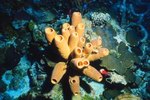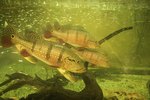
Humans and other animals are deeply intertwined. Several animals help contribute to the survival of other species, including humans. From pollinating crops to cleaning up oceans, there are many roles animals play in preserving the existence of the human species and the planet.
Bats: Pollination Plus Fertilization
Bats may seem scary to some, but they are quite beneficial to humans' health. They eat various insects, including mosquitoes, which can carry disease. Bats pollinate many crops, and fertilize them by depositing their guano. Unfortunately, bats are facing death in large numbers. White nose syndrome, a fungal disease plaguing these tiny mammals, has killed more than 5.7 million North American bats, according to WhiteNoseSyndrome.org. Scientists are investigating the disease in hopes of controlling it.
Butterflies: Predicting Weather and Looking Good
Butterflies are more than just a pretty face. According to Science Daily, they can help predict climate change trends. The Climatic Risk Atlas of European Butterflies, a book connecting climate change risks with the future of European butterflies, applies research from numerous scientists and helps correlate climate change and butterfly survival. These studies offer information that can be used to make appropriate climate change recommendations. Ideally, this can help humans survive if appropriate climate change protocols are implemented.
Fish: Keeping The Waters Clean
Fish not only provide an important food source, but they can help clean up the oceans and fight climate change. A study from the University of Exeter in the United Kingdom found fish excrement may help reduce the level of climate-changing carbon dioxide in the water. Fish ingest large amounts of saltwater, and later excrete lumps of calcium carbonate, known as "gut rocks." These dissolve in the water and, in the process, reduce carbon dioxide levels.
Honeybees: Population Decline Is a Buzzkill
Honeybees are most famous for buzzing, stinging and making honey. However, their existence is vital to humans. Honeybees pollinate about 90 percent of the fruits and vegetables humans regularly consume. These include apples, asparagus, avocados, berries, broccoli, cantaloupe, cucumbers, soybeans, squash and others. But honeybees are dying in mass numbers, a phenomenon the US Department of Agriculture and the Center for Disease Control calls colony-collapse disorder, and they note it is a major threat to the food supply.
References
- Finding Dulcinea: 5 Animals We Need to Survive
- USA Today: Honey-Bee Die-Off Threatens Food Supply
- Science Daily: Butterflies Across Europe Face Crisis As Climate Change Looms
- New Scientist: Fish "An Ally" Against Climate Change
- Time Science & Space: Beepocalypse Redux: Honeybees Are Still Dying — and We Still Don’t Know Why
- White-Nose Syndrome: About White-Nose Syndrome
Photo Credits
-
Thinkstock Images/Comstock/Getty Images
Writer Bio
Sarah Whitman's work has been featured in newspapers, magazines, websites and informational booklets. She is currently pursuing a master's degree in nutrition, and her projects feature nutrition and cooking, whole foods, supplements and organics. She also specializes in companion animal health, encouraging the use of whole foods, supplements and other holistic approaches to pet care.



